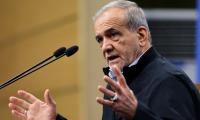It is time to look beyond Budget 2023. The government’s chosen goal for the budget, despite the clamour and possible changes, is to avoid default.
It is a crucial goal. Yet, above the numbers, there should be higher ambitions – such as avoiding future crises, improving living standards, and building the nation’s solidarity and self-esteem. The government may eventually give a moment to such thoughts, if they have the time. So far, they are focused on making ends meet.
So, while we wade our way through another crisis, I believe the country must also sow the seeds for a future with a more buoyant economy and an open society.
The long road down: Rehashing how we keep getting into the mess is important because we have not learned any lesson. The real test of a people is how they get out of a rough spot once they are in one. Even more so, it is about what means we use to get out of the mess and to learn not to make a habit of getting into trouble time and again.
So far, with each crisis the country has piled debt on debt to settle past dues to our creditors. While that is needed again now, it is hardly strategy. This minimalist goal of avoiding default ensures that before long we are back into another crisis.
The current mantra about why we are frequently in a crunch is ‘elite capture’. Privileges for special interests cause much harm, of course. Yet, lack of strategic thinking is the greater perpetrator.
The economy needs a strategy to revive growth and exports. Growth will solve the top concern of our youth, jobs. Jobs come only from more production and higher growth. And if GDP growth leads to higher exports, at one fell swoop we will achieve more than just jobs.
Growth in exports will help with decent jobs and combat the country’s enduring affliction of external imbalance. By increasing supply of goods, growth also acts against high prices.
In this series of columns, I propose a growth strategy. This could, in about five years, put the economy on a path of stability and development. It would also minimize our dependence on others.
Let us take a moment to see where we are today. Runaway twin deficits define our present state. FY22 budget deficit is estimated to be nine per cent of GDP and the current account deficit could be four per cent or more. And each day brings news about the rupee’s further fall. The slowdown in the economy and the high inflation have been made worse by doubt and failure to act decisively. With mixed signals from the IMF, the risks to the economy are high.
At home and abroad, the government is running out of options to borrow. Within the country, the government’s borrowing cost is over 15 per cent. The high rate of borrowing at home is exhausting the banking sector’s limits. As the cost of credit grows, the private sector finds it may no longer be in the market.
Externally, major lenders would not oblige until they have the IMF’s assurance. To get IMF support means more pain for citizens and a high political cost for the government.
All this is because of very high public indebtedness. Pakistan’s debt has grown to a level where loans cannot be repaid. The budget for markup payments on foreign and domestic debt is 45 per cent of federal spending. Such large sums take money away from more vital needs. Servicing of external debt alone is now four per cent of GDP. That is, four per cent of Pakistan’s GDP goes overseas. High import and debt servicing needs have led to a constant current account deficit and frequent crises. Each crisis slows down the economy. Businesses suffer loss and citizens face hard times.
This freefall has been years in the making, across many governments. Though the IMF is needed, let us try to make it the last time. Or one of the last times. Clambering back – a strategy for growth: To deal with all this, the economy must grow rapidly. Rapid growth would yield more tax revenue to invest in public goods that help firms produce more. Also, GDP must increase over long periods, not just for one or two years. For that to happen, the economy’s quality of growth must improve. Growth should increase production of manufactured goods for exports.
The picture is the opposite today. Export has fallen continually for 30 years. It was 19 per cent of GDP in 1990. The ratio of export to GDP now stands at about 10 per cent. Fall in export is a major cause of our external account troubles, as the economy does not earn enough to import or repay.
The same goes for investment: To produce more manufactured goods, firms need good infrastructure, human resources and incentives. The economy’s high debt burden leaves little in the public kitty to afford the needed public goods. Nor can the private sector easily access credit. Thus, we have to think of new ways to create credit so that private firms can invest. The economy will not grow without more investment.
The remaining part of this essay will focus on how to achieve growth that spurs export and creates jobs. For that, it is vital to stretch the limits imposed by us on our thinking. For years, there has been an inevitability in the country’s approach – that is: the only way to grow or exit economic troubles is to take on more debt. We have also assumed that poverty is destined. The economy is weak and dependent because we choose it to be so.
A growth strategy needs an enduring cycle of more public and private investment, exports, and less foreign debt.
On the public side, a short-of-cash government has to find money by both increasing revenue and cutting expenses. That will allow it to invest more in public goods.
For private investment, the economy must keep credit flowing. I propose ways of doing so, even as the economy stays within the monetary limit.
To be continued
The writer, former commerce minister, is chair and CEO of the Institute for Policy Reforms.
Beijing was among first to denounce the tariffs, calling them “unjustifiable” and vowing strong countermeasures
With this unprecedented buildup, Diego Garcia has transformed into ticking time bomb of apocalyptic power
Pakistan is among world’s most climate-vulnerable nations, despite contributing minimally to global emissions
‘Azazeel’ is perhaps the most controversial novel to come out in Egypt this century
Dr Haroon Ahmed was an exceptional person, a precious human being who strived, throughout his long life
Pakistan can't afford another status quo budget so it must be budget of imagination, risk-taking and system-level...







